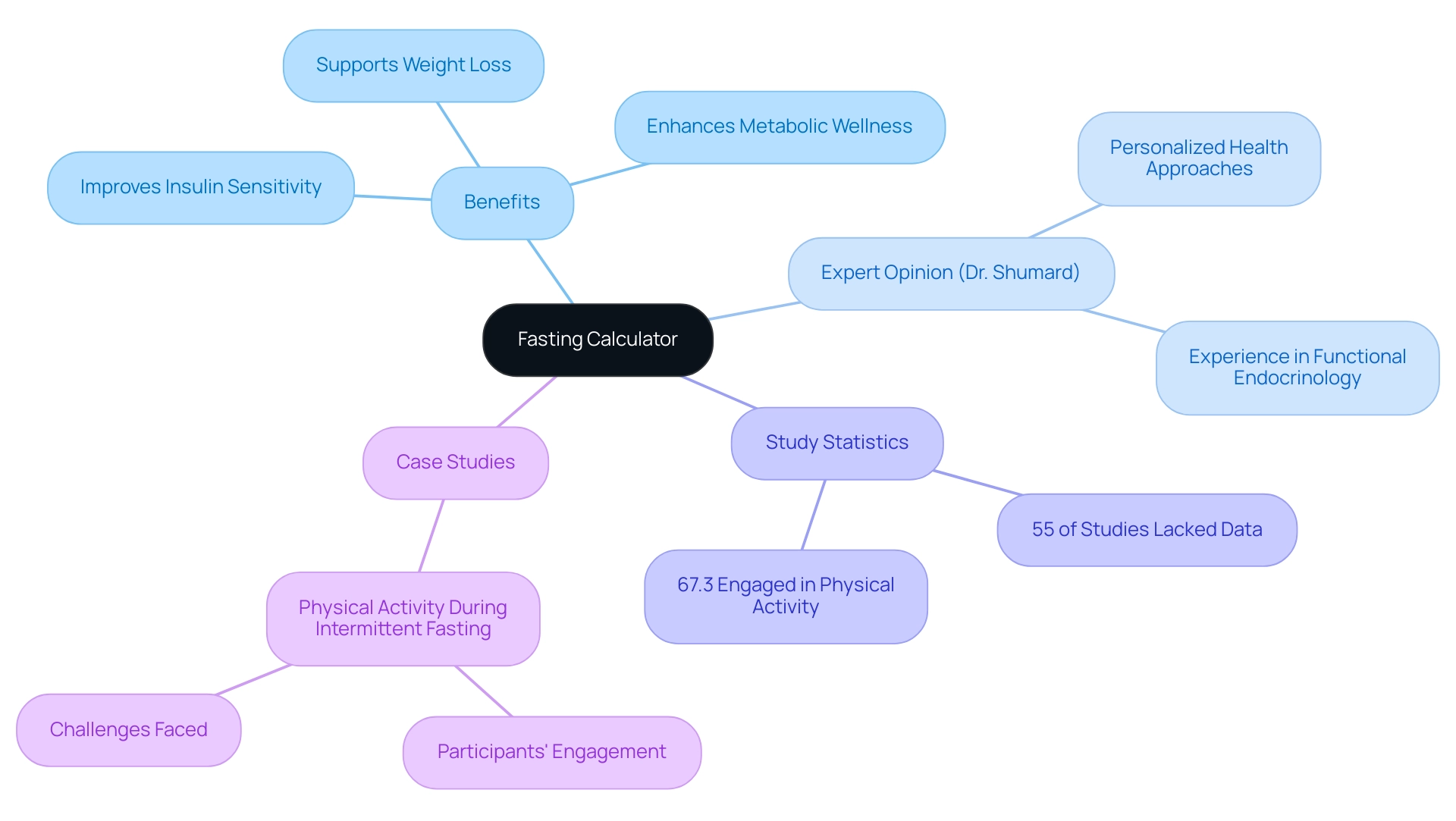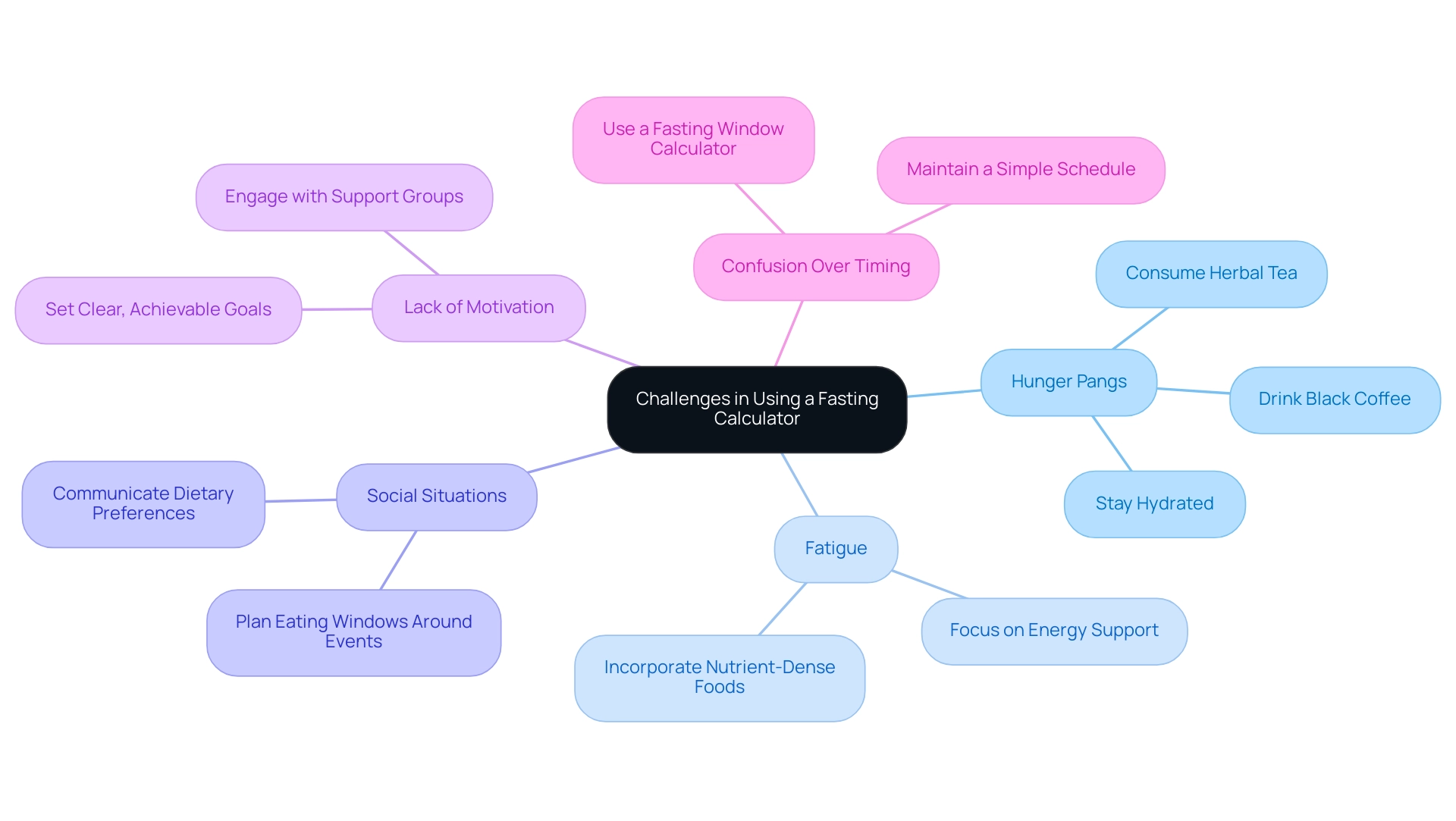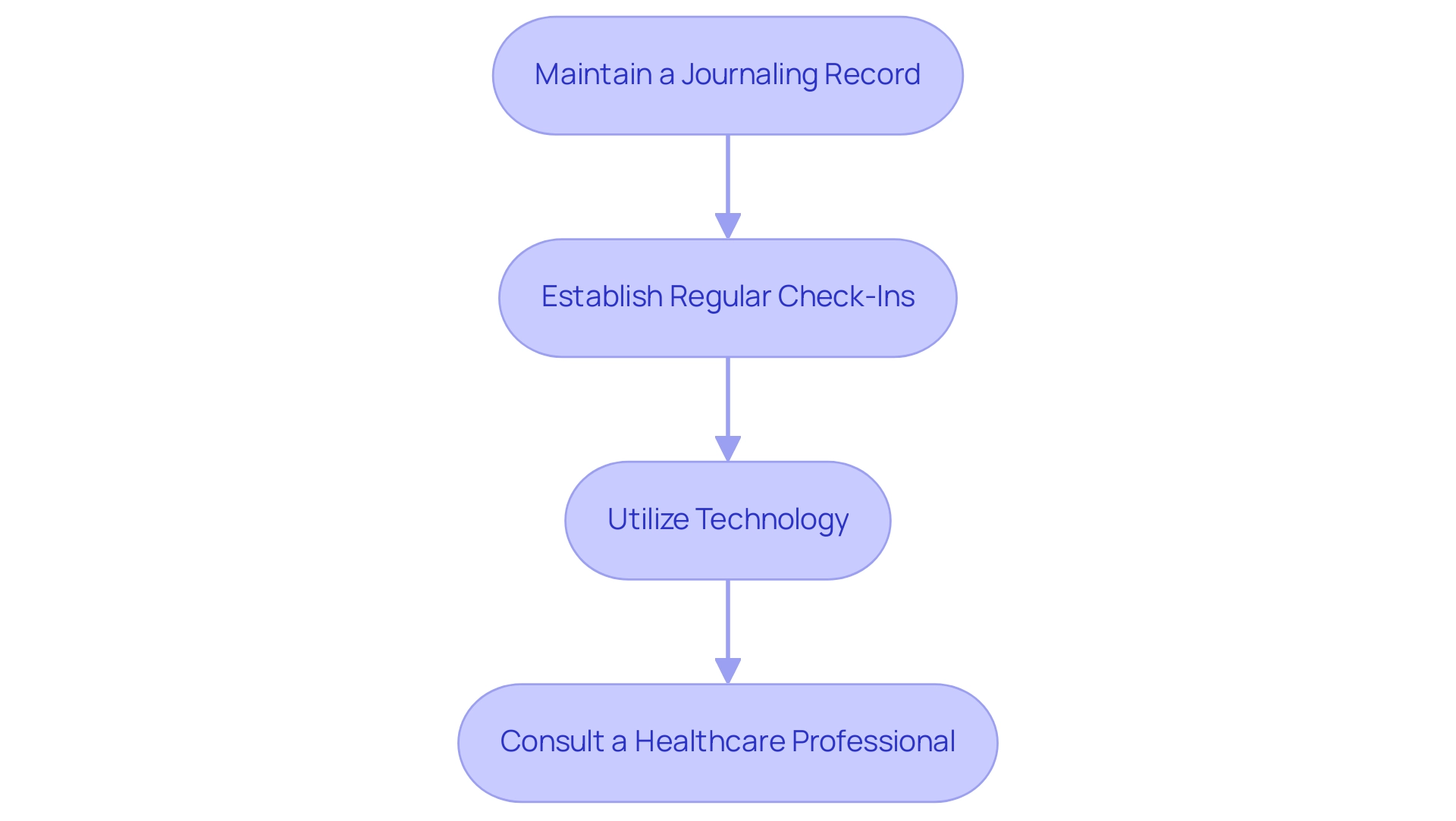Overview
The article provides a comprehensive step-by-step guide on how to effectively use a fasting window calculator, emphasizing its role in personalizing dietary approaches for improved health outcomes. By detailing the process of selecting a dietary method, inputting personal information, and adjusting fasting schedules based on individual needs, the article illustrates how utilizing this tool can enhance insulin sensitivity and support overall wellness, particularly for those managing conditions like type 2 diabetes.
Introduction
Navigating the complexities of health and nutrition can be overwhelming, especially when it comes to understanding the nuances of intermittent fasting. A fasting window calculator emerges as a vital resource, enabling individuals to personalize their fasting schedules based on unique health goals and lifestyles. This article delves into the significance of fasting calculators, particularly within the framework of functional medicine, where tailored approaches are essential for managing conditions like type 2 diabetes.
By exploring the step-by-step process of using a fasting calculator, common challenges faced during fasting, and strategies for maximizing the benefits of this dietary practice, readers will gain valuable insights into how to effectively integrate intermittent fasting into their health routines.
Whether seeking to improve metabolic health or simply looking to adopt a more structured eating pattern, understanding these tools can empower individuals to take charge of their wellness journey.
Understanding the Fasting Calculator: What It Is and Why You Need It
A fasting window calculator is a vital instrument that allows individuals to identify their ideal periods for abstaining from food and consuming meals, customized to their particular wellness objectives and lifestyles. In the realm of functional medicine, especially at Dr. Jason Shumard’s Integrative Wellness Center of San Diego, this tool aids the successful application of intermittent nourishment, a method that has demonstrated potential in controlling type 2 diabetes and enhancing metabolic wellness. Dr. Shumard, who has nearly 20 years of experience and postgraduate education in functional endocrinology and clinical nutrition, emphasizes the importance of personalized approaches to health.
By calculating the timing of eating intervals, patients can enhance insulin sensitivity and manage their blood sugar levels more effectively. Recent studies indicate that 6 out of 11 studies (55%) included in the umbrella review did not provide a mean or standard deviation, highlighting the methodological limitations in dietary studies and the importance of reliable tools like calculators. Additionally, using a fasting window calculator enables individuals to manage their eating practices, encouraging lasting wellness results.
As noted by Ming-Li Sun, ‘this UR has systematically assimilated this vast amount of existing evidence where it has been published in a meta-analysis,’ emphasizing the effectiveness of dietary calculators. Moreover, a case study named ‘Physical Activity During Periodic Abstinence from Food’ uncovered that 67.3% of participants participated in physical activity while abstaining from food, indicating that merging exercise with periodic abstinence can improve weight loss and overall wellness, aligning with Dr. Shumard’s holistic strategy to reversing type 2 diabetes and hypothyroidism. For tailored assistance and to discover more about how dietary calculators can enhance your well-being, reach out to Dr. Shumard at 858-564-7081.
Step-by-Step Guide to Using a Fasting Window Calculator
-
Choose Your Dietary Approach: Begin by selecting a time-restricted eating method that aligns with your lifestyle and health objectives. Popular approaches include the 16/8 method, where you fast for 16 hours and eat within an 8-hour window, and the 5:2 method, which allows normal eating for five days while restricting calories on two non-consecutive days. Research indicates that these methods can be effective, leading to significant fat loss while preserving muscle mass. In fact, a randomized trial has demonstrated that intermittent eating can be as effective as daily calorie restriction, making it a viable option for many individuals.
- Access the fasting window calculator: Locate a reputable eating window calculator online. Numerous health-oriented websites provide user-friendly tools aimed at supporting your dietary journey.
- Input Your Information: Enter your chosen dietary method along with any pertinent personal details, such as age, weight, and specific health goals. This data is vital, as it enables the calculator to provide tailored recommendations that suit your individual needs, particularly in relation to understanding your A1C levels and translating them to Estimated Average Glucose (eAG) for enhanced diabetes management. Additionally, consider using conversion formulas and charts that can help clarify how your A1C levels relate to your overall glucose management.
-
Calculate Your Fasting Windows: Upon entering your information, click the ‘Calculate’ button. The fasting window calculator will generate your personalized eating and abstaining windows based on the selected method. Significantly, research has demonstrated that periodic abstention from food can be as effective as daily calorie limitation, rendering this method a valuable asset. Furthermore, it’s worth noting that 44% of Americans were on a diet in 2022, highlighting the growing interest in dietary methods like intermittent fasting.
-
Review and Adjust: Evaluate the recommended fasting schedule. It is important to consider how this plan fits into your daily routine. If necessary, make adjustments to ensure the schedule is sustainable and convenient for you, as flexibility is crucial for long-term adherence. This is especially important in the context of personalized functional medicine solutions for diabetes management, which emphasize individualized care. Consulting with a functional medicine practitioner can provide insights tailored to your unique wellness needs.
-
Implement Your Fasting Schedule: Begin following your fasting schedule and closely monitor its impact on your energy levels and overall well-being. Record any challenges you encounter and be ready to make changes as necessary, ensuring that your approach stays aligned with your wellness objectives. This alignment is key in managing the condition effectively, as indicated by the importance of A1C testing for informed treatment adjustments.
-
Consult with a Professional: If you have any concerns, particularly regarding diabetes management, it is advisable to consult with a healthcare provider or a certified diabetes coach. As Professor Obaid Al-Modaf stated, the expertise level of medical professionals is crucial in making informed decisions related to wellness. This step guarantees that your abstaining plan is both secure and efficient, enabling you to utilize the advantages of periodic abstinence while prioritizing your well-being and customizing your care approach.
Common Challenges When Using a Fasting Calculator and How to Overcome Them
- Hunger Pangs: Experiencing hunger during abstinence is a common occurrence. To mitigate this sensation, it is essential to remain well-hydrated; consuming water, herbal tea, or black coffee can help. Often, individuals may mistake feelings of hunger for thirst, so prioritizing hydration can alleviate discomfort. As Jade Mihalicz, a medical researcher, observes, “With celebrities, fitness brands, professionals, and wellness specialists all endorsing the advantages of periodic abstaining from food, we can anticipate a rise in this dietary approach.”
- Fatigue: Beginners might encounter fatigue as their bodies adapt to a new eating schedule. To combat this, focus on incorporating nutrient-dense foods during your eating windows. This approach not only provides essential energy but also supports overall health. Notably, studies indicate that 4.1% of individuals experienced a significant weight loss of 10 kg or more, showcasing the potential effectiveness of intermittent dietary practices.
- Social Situations: Navigating social gatherings while abstaining from food can present challenges. It is advisable to plan eating windows around social events or to communicate dietary preferences with friends and family. Such strategies can reduce social pressure and create a more supportive environment. The adaptability of intermittent eating, as highlighted in the case study ‘Intermittent Eating vs. Other Diets,’ enables individuals to enjoy meals within their eating windows, making it easier to incorporate this approach into daily life.
- Lack of Motivation: Maintaining motivation throughout the abstaining journey can be a struggle. Setting clear, achievable goals and tracking progress can foster a sense of accomplishment. Additionally, engaging with a community or support group can provide the encouragement needed to stay committed.
- Confusion Over Timing: Newcomers often find it challenging to use a fasting window calculator to calculate their eating windows accurately. To streamline this process, consider maintaining a simple schedule or using a fasting window calculator to help you stay organized and focused on your fasting regimen.
Tips for Maximizing the Benefits of Intermittent Fasting
-
Focus on Nutrition: Prioritizing whole, nutrient-dense foods during your eating windows is essential. While including a range of vegetables, lean proteins, and healthy fats is advantageous, it’s essential to acknowledge that whole grains may not be appropriate for everyone, especially those managing Type 2 conditions. Individual dietary needs vary greatly, and some diabetics might not effectively break down whole grains. The American Diabetes Association suggests that low-carb diets, which would eliminate grains altogether, might be a smarter option for those with diabetes. Consulting with a healthcare professional to customize your eating plan can help ensure optimal wellness outcomes.
-
Stay Hydrated: Adequate hydration is crucial, particularly during times of abstaining from food. Drinking plenty of water can help mitigate feelings of hunger and support overall health. Staying hydrated is a simple yet effective way to enhance your experience during the fast.
-
Listen to Your Body: Monitoring your body’s responses is vital as you embark on your journey of abstaining from food. If you encounter unusual symptoms like anxiety or headaches, it may suggest that modifications are required in your eating schedule. This is particularly significant considering that numerous individuals mention these symptoms when beginning periodic dietary restrictions. Consulting with a healthcare professional is advisable, particularly for those with pre-existing health conditions.
-
Include Physical Activity: Regular exercise enhances periodic dietary restrictions by amplifying its benefits. Aim for a balanced fitness routine that includes both cardiovascular and strength-training exercises. However, remain attuned to your body’s signals and modify the intensity of your workouts according to your energy levels.
-
Be Patient: Results from intermittent eating can take time to manifest. Research suggests that it may take two to four weeks for your body to fully adjust to this eating pattern, during which many individuals report improved feelings. Stay dedicated to your dietary plan, and celebrate small achievements along the way to maintain motivation. As nutritionist Amy Richter observes,
If you feel good when abstaining from food and find it to be a sustainable way of eating, it can be a very powerful tool to lose weight and improve your health.
Furthermore, the 16/8 approach is broadly seen as the easiest and most sustainable type of eating pattern, making it a favored option for many.
-
Safety and Side Effects: It’s important to be aware of common side effects of periodic eating, such as hunger and temporary weakness. If you have any health issues, seeking advice from a physician before beginning a periodic eating regimen is strongly advised, as this can help guarantee that your method is safe and appropriate for your personal situation.
Tracking Your Progress and Adjusting Your Fasting Plan
- Maintain a Journaling Record: Keeping a detailed journaling record is essential for tracking your intermittent abstaining from food journey, particularly for managing blood sugar levels effectively. Record your eating schedule, energy levels, and any physical or emotional changes you experience during this period. This practice not only aids in identifying patterns but also highlights areas where adjustments may be beneficial. Notably, research indicates that the effectiveness of fasting journals can vary; nearly 48% of meta-analyses show a reliance on fewer than ten original studies, underscoring the need for more comprehensive tracking methods to ensure accurate monitoring of your progress. This is particularly important for pregnant individuals to avoid gestational complications by closely monitoring blood sugar levels.
- Establish Regular Check-Ins: Regular evaluations are crucial for assessing progress towards your wellness objectives, especially for those looking to eliminate insulin dependency and prevent gestational diabetes. Arrange weekly or monthly meetings to assess your dietary habits and wellness metrics. During these evaluations, consider what adjustments to your eating schedule or habits may be necessary based on the insights you gather. This repetitive procedure is essential for coordinating your dietary schedule with your metabolic objectives and avoiding issues such as gestational complications.
- Utilize Technology: Employing technology can greatly improve your experience of abstaining from food and enable you in managing blood sugar levels. Several applications are specifically created to monitor intermittent food abstinence with a fasting window calculator, providing features that enable you to record durations of not eating, track weight changes, and evaluate overall wellness patterns. As you incorporate these tools, you may discover that they offer valuable perspectives on your eating patterns and their effects on your well-being, contributing to a comprehensive strategy for reversing type 2 conditions and hypothyroidism, as well as managing blood sugar levels during pregnancy.
- Consult a Healthcare Professional: If your current dietary plan does not yield the anticipated results, it is essential to seek guidance from a healthcare provider or diabetes health coach. Their expertise can provide personalized insights and adjustments tailored to your unique needs. Adriana Villasenor, PhD at the Moores UCSD Cancer Center, emphasizes that current recommendations for weight loss often include advice to eat regular meals to prevent excessive hunger, highlighting the importance of professional input in maintaining a balanced approach to periodic calorie restriction. Furthermore, managing food choices during intermittent abstinence is crucial; a case study titled “Metabolic Health and Overeating” illustrates that overeating during the eating window, especially with high-sugar and unhealthy fat foods, can lead to spikes in blood sugar and insulin levels, contributing to insulin resistance. This reinforces the necessity of careful food selection to support your fasting efforts and overall diabetes management, particularly in the context of preventing gestational diabetes.
Conclusion
Understanding the role of a fasting window calculator is crucial for effectively integrating intermittent fasting into a health regimen. By personalizing fasting schedules based on individual health goals and lifestyles, individuals can optimize their fasting experience, particularly in managing conditions like type 2 diabetes. The article outlined the importance of using a fasting calculator, navigating its functionalities, and addressing common challenges faced during fasting. These insights empower individuals to take control of their dietary habits, promoting sustainable health outcomes.
Moreover, practical tips for maximizing the benefits of intermittent fasting include:
- Focusing on nutrition
- Staying hydrated
- Incorporating physical activity
These highlight the multifaceted approach necessary for success. Tracking progress, maintaining a fasting journal, and leveraging technology are essential steps for ensuring adherence to fasting plans and making necessary adjustments for optimal results. Consulting with healthcare professionals can further personalize these strategies, ensuring safety and effectiveness.
In conclusion, adopting a structured approach to intermittent fasting through the use of a fasting calculator can significantly enhance metabolic health and overall well-being. By understanding the tools available and implementing best practices, individuals can navigate their health journeys with confidence, making informed choices that lead to lasting improvements in their health.
Frequently Asked Questions
What is a fasting window calculator?
A fasting window calculator is a tool that helps individuals determine their optimal eating and fasting periods based on their health goals and lifestyles, particularly useful for implementing intermittent fasting.
How does the fasting window calculator assist with health management?
It aids in enhancing insulin sensitivity and managing blood sugar levels, which can be beneficial for conditions like type 2 diabetes and metabolic wellness.
Who is Dr. Jason Shumard and what is his role related to the fasting window calculator?
Dr. Jason Shumard is a functional medicine expert with nearly 20 years of experience. He emphasizes personalized health approaches and utilizes the fasting window calculator at his Integrative Wellness Center to support patients.
What dietary approaches can be chosen when using a fasting window calculator?
Popular approaches include the 16/8 method (fasting for 16 hours and eating within an 8-hour window) and the 5:2 method (normal eating for five days and calorie restriction on two days).
How do you use a fasting window calculator?
Users select their dietary method, input personal information (like age and weight), calculate their fasting windows, review and adjust the schedule as needed, and then implement the fasting plan while monitoring its effects.
What should be considered when reviewing the fasting schedule generated by the calculator?
It’s important to assess how the recommended fasting schedule fits into your daily routine and to make adjustments for sustainability and convenience.
What should you do if you have concerns about your fasting plan or diabetes management?
It is advisable to consult with a healthcare provider or a certified diabetes coach to ensure the fasting plan is safe, effective, and tailored to your individual needs.


